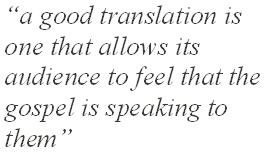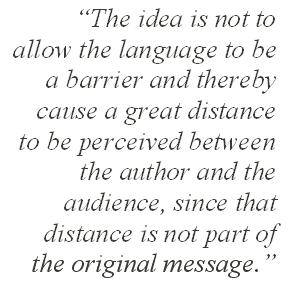ESPAÑOL
On translating the Bible (1):
Introduction
Like any other modern Bible translation, the Ne Bibliaj Tik Nawat project aims to make it possible for speakers of a language other than Hebrew or Greek to read or hear the text of the Bible and experience its content and message. In the first of a series of articles, Ne Bibliaj translator Alan King looks at what this means.

Every language involves a unique range of words, meanings, ideas, previous experiences, common assumptions and a distinctive cultural background, and when as speakers of such a language we read a text the words and sentences inevitably interact with all the previous knowledge and expectations. The message we actually obtain from a text results from that complex process.
The translator's task, of course, is to give the reader an idea of the words and sentences in the original text. It is only an idea, since a translation can never be the same as the original. But a good translator's task involves something even more important than the words, and that is the message.
Words and message are not at loggerheads but constitute two facets of the Biblical text that both need to be reflected in a faithful translation. This involves a certain amount of compromise at times, but that is inherent in any act of translation in the first place. That is the reason why translation should be informed by modern approaches and theories on the subject. The old idea that literal (word-for-word) translation necessarily conveys most faithfully to the reader of the translation the intended message of the original text is now known to be unsound, as becomes more obvious the more becomes known about the great diversity among the world's languages and the societies who speak them or have spoken them at different times in history.
One sometimes reads that there are two approaches to Bible translation, one that emphasises literal correspondence to words of the original and one which embraces paraphrase as a way of conveying its meaning, but this hardly makes sense other than as a vague classificatory concept. All translations endeavour not to veer further than necessary from the original and all involve some degree of creativity in using the resources of the target languages and appealing to the particular experiences and knowledge of the target audience to ensure the translation is intelligible. The crucial issue is not which "method" (word-for-word or paraphrase) is used, but how skilfully the two are combined at every turn in the intricate process of translation.
One conclusion to be drawn is that translation should whenever possible be directly from the original, straight into the target language. Since no translation can help diverging in some respect from the original, a translation is not itself a good source from which to retranslate into a third language, since this can only lead to compounding such divergences, whereas the goal is to remain as faithful as possible to the original words and the original message. In particular, it sometimes occurs that a particular concept or turn of phrase is present in the original text and also available in the target language, making possible a "direct hit" for the translator working directly between the two languages, but such a concept or construction is absent from an intermediate language in which a translation is available. Thus if the existing translation is taken as the basis of the new one in such a case, the latter will not reflect the original text directly even though it could have done, owing to the paraphrase present in the intermediate translation. It is the translation philosophy of Ne Bibliaj Tik Nawat that only the best translation humanly possible is acceptable, and that can only be provided by translating direct from the original.
 The original gospels (the texts to be translated first in this project) were initially addressed to a Greek-reading audience (or one who understood the Greek text when it was recited by a reader). Such people were the intended audience for whom the gospels had been written and who, when they read or heard the evangelists' words, perceived those words to be addressed to themselves and received their message as such. The original gospels (the texts to be translated first in this project) were initially addressed to a Greek-reading audience (or one who understood the Greek text when it was recited by a reader). Such people were the intended audience for whom the gospels had been written and who, when they read or heard the evangelists' words, perceived those words to be addressed to themselves and received their message as such.
A good translation of the gospels will be one that, while extending further their audience, allows the "new" target audience to experience the same feeling that the gospel is speaking to them.
That can hardly be achieved if the text sounds like it was addressed to people very different from themselves who lived thousands of years ago and had a completely different background pertaining to an alien culture. In a deep, non-anecdotic sense, a Pipil audience ought to feel that Jesus might have been a Pipil. And this must be conveyed without mangling the essential original message, yet conveying it is also itself part of that essential original message.
An overly literal translation tends to make the language sound strange, unnatural, wooden and remote, and in so doing fails to reflect many of the literary qualities of the prose and poetry of the original Bible, which is often quite the opposite: captivating, suggestive, idiomatic and flowing. The purpose of flexibility in translation is not (or in our opinion should not be) to rework, reformulate or otherwise rehash the text but simply to give the reader a more genuine experience of it in the sense that this experience resembles more closely the experience that could be attained on reading the original.
 This is not to underestimate the addressee's capacity to take into account when and where biblical events actually occurred and were written of in the Bible. It is not our intention to deny or conceal the fact that Jesus was born in Galilee two thousand years ago, rather than in ancient Syria or Rome or present-day Nahuizalco, Tacuba or Panchimalco. This is not to underestimate the addressee's capacity to take into account when and where biblical events actually occurred and were written of in the Bible. It is not our intention to deny or conceal the fact that Jesus was born in Galilee two thousand years ago, rather than in ancient Syria or Rome or present-day Nahuizalco, Tacuba or Panchimalco.
The idea is simply not to allow the language of the texts to turn into a barrier and thereby artificially cause a great distance to be perceived between the author and the Pipil audience whereas the original hearer of the original text perceived no such barrier or distance, since that distance is not an intended part of the original message.
Ne Bibliaj Tik Nawat, then, aims to provide a quality translation of the Bible into Nawat. The translation process undertaken includes:
- diligent study of the words and meanings of the source texts in their original language
- comprehensive and painstaking research into the target language and its expressive resources
- thoughtful and systematic development of relevant translation techniques and careful consideration of the issues that arise.
In future articles in this series I will look at each of these points in some more detail.
| 






